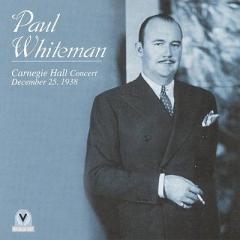Paul Whiteman - Carnegie Hall Concert (1938)
Paul Whiteman - Carnegie Hall Concert (1938)

CD-1: 1.Introduction By Deems Taylor (5:37) 2.The Farmer Leaves The Hay (4:47) 3.Blue Belle Of Harlem (7:01) 4.Cowbell Serenade (4:32) 5.Quonk (5:48) 6.The Seventh Day (7:15) 7.The Bell Fugue (5:30) 8.St. Louis Blues (14:43) 9.Gay Mood,Peasant Song And Finale Opus 1 (10:16) CD-2: 1.Cuban Overture (14:24) 2.Talk (10:37) 3.Nursery Ballet (2:33) 4.Bumpy Weather Over Newark (4:28) 5.Suicide Cliff (3:47) 6.Mexican Jumping Bean (4:38) 7.Trylon And Persiphere (13:03) 8.Shadrack (4:06) 9.Nobody Knows The Trouble I've Seen (4:23) 10.Rhapsody In Blue (8:45) Recorded Live At Carnegie Hall,December 25,1938 Paul Whiteman (leader); Jackie Bell, Murray Cohan (flute,piccolo,oboe,alto & baritone sax); Vincent Capone (flute,tenor sax); George Ford, Harold Feldman (piccolo,oboe,English horn); Frank Gallodoro, Art Drelinger (clarinet,bass clarinet,tenor sax); Salvator Franzella (clarinet,alto sax); Pete Pumiglio, Artie Shaw (clarinet); Anton Malay (oboe); Nat Reines, Morris Kirchner (bassoon); Dave Harris (tenor sax); Goldie Goldfield, Bob Cusmano, Bob Axley, Russ Case, Charlie Teagarden (trumpets); Jack Teagarden, Vincent Grande, Miff Mole (trombones); Norman McPherson (tuba); Frank Signorelli, Rosa Linda, Walter Gross, Roy Bargy (piano); Art Ryerson (guitar); Mike Pingatone (banjo); George Wettling (drums); Louis Armstrong (vocal); Strings Orchestra.
In the 1920s Paul Whiteman was billed as "The King of Jazz," but his brand of concert music only used jazz as an ingredient, not as the main dish. Whiteman often employed major jazz musicians and singers, most notably cornetist Bix Beiderbecke, C-melody saxophonist Frankie Trumbauer, the Dorsey Brothers, Bing Crosby and Mildred Bailey, and he had occasional jazz performances. But his general audience was interested in dance music and his main goal, like that of Stan Kenton 20-years-later, was to create a new form of music that combined the more "civilized" aspects of jazz with classical music. One of Whiteman's most notable performances was in 1924 at Aeolian Hall when his band, with George Gershwin on piano, debuted "Rhapsody in Blue." It was the first of eight Experiment In Modern American Music concerts that he organized over a 14-year-period which were designed to present fresh new third stream pieces along with some of Whiteman's repertoire from the era. Among the pieces that received early performances at these concerts were Bix Beiderbecke's "In a Mist" (which Bix played on piano), Gershwin's Concerto in F, Ferde Grofé's "Metropolis" and "Grand Canyon Suite." The eighth and final concert in this series took place December 25, 1938 and is released for the first time on this double-CD Carnegie Hall Concert. Deems Taylor is the narrator and emcee. His good-natured and often humorous comments are a major asset to the concert. Although most of the music is not jazz, there are exceptions. Artie Shaw, who had become a household name that year, is featured in brilliant form on clarinet throughout a 14-and-1/2-minute blues exploration titled "St. Louis Blues" but often hints at his Concerto for Clarinet which would not debut until 1940. Louis Armstrong sings (but unfortunately plays no trumpet) on the spirituals "Shadrack" and "Nobody Knows the Trouble I've Seen" with the Lynn Murray Singers. And the Raymond Scott Quintette (or at least four members of the popular novelty group including the leader) performs "Bumpy Weather Over Newark," "Suicide Cliff" and "Mexican Jumping Bean."
Otherwise, the music is outside of jazz. Whiteman in his large orchestra had such fine improvisers as trombonists Jack Teagarden and Miff Mole, trumpeter Charlie Teagarden, guitarist Art Ryerson (father of flutist Ali) and drummer George Wettling. But other than Jack Teagarden having a mournful blues solo on "Suicide Cliff" and a few very brief spots on "Blue Belle of Harlem," none of those players are heard from except buried in the huge and dense ensembles. In addition to the pieces mentioned, there are highly arranged works by Duke Ellington ("Blue Belle of Harlem"), Walter Gross, Fred Van Eps, Roy Bargy, Morton Gould, George Gershwin ("Cuban Overture"), Richard Rodgers ("Nursery Ballet"), Ferde Grofé and a few lesser-known composers. Most of the music is fairly colorful and the eighth and final concert concludes with a version of the hit from the first concert in the series, "Rhapsody in Blue." This historic release has enough intriguing music to make it recommended to listeners open to both classical music and swing. ---Scott Yanow, Rovi
download: uploaded yandex 4shared mediafire solidfiles mega filecloudio nornar








